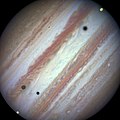Файл:Galilean satellite triple conjunction 2015-01-24 (right).jpg

Сығанаҡ файл ((1000 × 1000 пиксель, файл күләме: 584 Кб, MIME-төр: image/jpeg))
Был файл һаҡлау урыны Викиһаҡлағыста һаҡлана. Уның тураһында мәғлүмәттәр түбәндә күрһәтелгән.
Викиһаҡлағыс — Викимедиа проекттарында ҡулланылған ирекле файлдар өсөн үҙәкләштерелгән һаҡлағыс. |
Ҡыҫҡа аңлатма
| ТасуирлауGalilean satellite triple conjunction 2015-01-24 (right).jpg |
English: Firing off a string of snapshots like a sports photographer at a NASCAR race, NASA's Hubble Space Telescope captured a rare look at three of Jupiter's largest moons parading across the banded face of the gas-giant planet: Europa, Callisto, and Io.
These so-called Galilean satellites (named after the 17th century scientist Galileo Galilei, who discovered them with a telescope) complete orbits around Jupiter ranging from 2 days to 17 days in duration. They can commonly be seen transiting the face of Jupiter and casting shadows onto its cloud tops. However, seeing three moons transiting the face of Jupiter at the same time is rare, occurring only once or twice a decade. The Hubble image on the left shows the beginning of the event, which took place on January 24, 2015. From left to right the moons Callisto and Io are above Jupiter's cloud tops. The shadows from Europa (not seen in the image), Callisto, and Io are strung out from left to right. Near the end of the event, approximately 42 minutes later (right-side image), Europa has entered the frame at lower left. Slower-moving Callisto is above and to the right of Europa. Fastest-moving Io is approaching the eastern limb of the planet; its shadow is no longer visible on Jupiter. Europa's shadow is toward the left side of the image, and Callisto's shadow to the right. (The moons' orbital velocities are proportionally slower with increasing distance from the planet.) Missing from the sequence is the moon Ganymede, which was outside Hubble's field of view and too far from Jupiter in angular separation to be considered part of the conjunction. The moons in these photos have distinctive colors. The ancient, cratered surface of Callisto is brownish; the smooth icy surface of Europa is yellow-white; and the volcanic, sulfur-dioxide surface of Io is orange. The apparent "fuzziness" of some of the shadows depends on the moons' distances from Jupiter. The farther away a moon is from the planet, the softer the shadow, because the shadow is more spread out across the disk. The images were taken with Hubble's Wide Field Camera 3 in visible light. |
|||
| Көнө | (released 5 February 2015) | |||
| Сығанаҡ | http://hubblesite.org/newscenter/archive/releases/2015/05/image/b/ and http://hubblesite.org/newscenter/archive/releases/2015/05/image/c/ (see also http://heritage.stsci.edu/2015/05/index.html) | |||
| Автор | NASA, ESA, and the Hubble Heritage Team (STScI/AURA) | |||
| Башҡа өлгөләр |
|
Лицензиялау
| Public domainPublic domainfalsefalse |
| Этот файл находится в общественном достоянии (англ. public domain), так как он был создан NASA (Национальным управлением по аэронавтике и исследованию космического пространства). Политика авторского права NASA гласит, что «Материал NASA не защищается авторским правом, если не указано иное». (См. Template:PD-USGov, страницу политики авторского права NASA или политику использования изображений JPL.) |  | |
 |
Предупреждения:
|
Файл тарихы
Файлдың күрһәтелгән ваҡытта ниндәй өлгөлә булғанын ҡарар өсөн баҫығыҙ: Дата/ваҡыт
| Дата/ваҡыт | Миниатюра | Үлсәмдәре | Ҡатнашыусы | Иҫкәрмә | |
|---|---|---|---|---|---|
| ағымдағы | 17:02, 19 февраль 2021 |  | 1000 × 1000 (584 Кб) | Charlestpt | File:Galilean satellite triple conjunction 2015-01-24.jpg cropped 50 % horizontally using CropTool with lossless mode. |
Файл ҡулланыу
Был файлды ҡулланған биттәр юҡ.
Файлды глобаль ҡулланыу
Был файл түбәндәге википроекттарҙа ҡулланыла:
- en.wikipedia.org проектында ҡулланыу
- fr.wikipedia.org проектында ҡулланыу
Метамәғлүмәттәр
Файл һанлы камералар йәки сканерҙар өҫтәгән мәғлүмәттәргә эйә. Әгәр файл яһалғандан һуң төҙәтелгән булһа, ҡайһы бер параметрҙар ағымдағы рәсем менән тап килмәҫкә мөмкин.
| Киңлек | 1000 пикс. |
|---|---|
| Бейеклек | 1000 пикс. |
| Төҫтәрҙең тәрәнлеге |
|
| Ҡыҫыу ысулы | LZW |
| Төҫтәр төҙөлөшө | RGB |
| Йүнәлеше | Ғәҙәти |
| Төҫтәр һаны | 3 |
| X күсәре буйынса асыҡлыҡ | 72 dpi |
| Y күсәре буйынса асыҡлыҡ | 72 dpi |
| Мәғлүмәттең ойошторолоуы ҡағиҙәһе | «chunky» форматы |
| Ҡулланылған программа тәьминәте | Adobe Photoshop Elements 12.0 Macintosh |
| Файлды үҙгәртеү көнө һәм ваҡыты | 12:31, 7 февраль 2015 |
| Exif өлгөһө | 2.21 |
| Төҫтәр киңлеге | sRGB |
| Метамәғлүмәттәрҙе һуңғы үҙгәртеү ваҡыты | 04:31, 7 февраль 2015 |
| Цифрлаштырыу көнө һәм ваҡыты | 04:26, 7 февраль 2015 |
| Сығанаҡ документтың уникаль идентификаторы | xmp.did:767D3918392068118083DF440090DADA |
